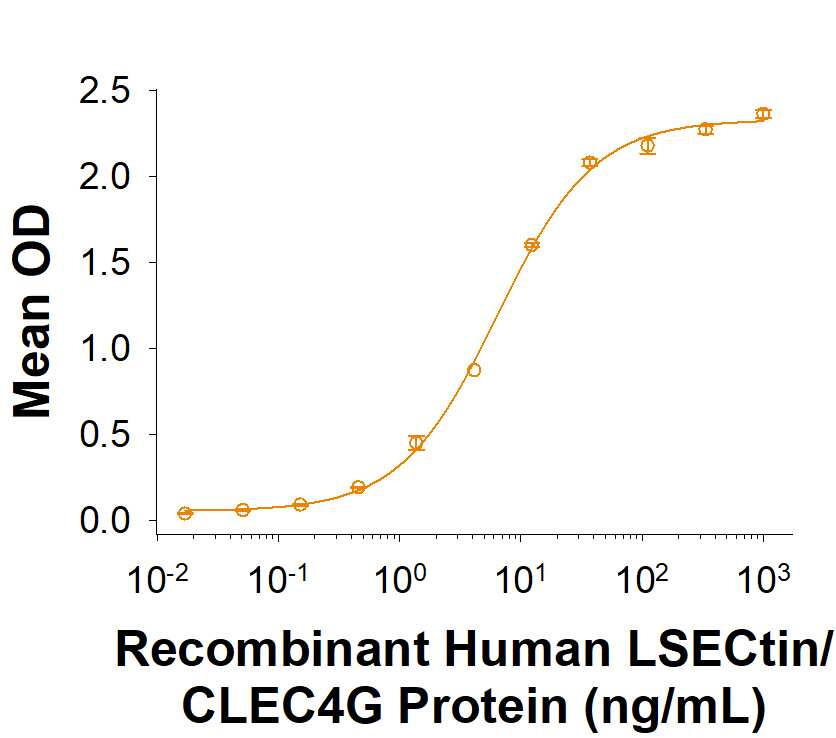Recombinant Human CD44v6 His-tag Protein, CF
R&D Systems, part of Bio-Techne | Catalog # 11237-CD

Key Product Details
Product Specifications
Source
Chinese Hamster Ovary cell line, CHO-derived human CD44 protein
| Human CD44v6 (Gln21-Thr222) IQATPSSTTEETATQKEQWFGNRWHEGYRQTPKEDSHSTTGTAG (Asp224-Trp269) Accession # NP_001001391.1 |
6-His tag |
| N-terminus | C-terminus |
Purity
>95%, by SDS-PAGE visualized with Silver Staining and quantitative densitometry by Coomassie® Blue Staining.
Endotoxin Level
<0.10 EU per 1 μg of the protein by the LAL method.
N-terminal Sequence Analysis
Gln21
Predicted Molecular Mass
33 kDa
SDS-PAGE
53-76 kDa, under reducing conditions.
Activity
Measured by its binding ability in a functional ELISA.
When Recombinant Human CD44v6 His-tag (Catalog # 11237-CD) is immobilized at 0.500 μg/mL (100 μL/well), Recombinant Human LSECtin/CLEC4G (Catalog # 2947-CL) binds with an ED50 of 3.00-15.0 ng/mL.
When Recombinant Human CD44v6 His-tag (Catalog # 11237-CD) is immobilized at 0.500 μg/mL (100 μL/well), Recombinant Human LSECtin/CLEC4G (Catalog # 2947-CL) binds with an ED50 of 3.00-15.0 ng/mL.
Scientific Data Images for Recombinant Human CD44v6 His-tag Protein, CF
Recombinant Human CD44v6 His-tag Protein Binding Activity.
Measured by its binding ability in a functional ELISA. When Recombinant Human CD44v6 His-tag Protein (Catalog # 11237-CD) is immobilized at 0.50 ug/mL (100 uL/well), Recombinant Human LSECtin/CLEC4G Protein (2947-CL) binds with an ED50 of 3.00-15.0 ng/mL.Recombinant Human CD44v6 His-tag Protein SDS-PAGE.
2 μg/lane of Recombinant Human CD44v6 His-tag Protein (Catalog # 11237-CD) was resolved with SDS-PAGE under reducing (R) and non-reducing (NR) conditions and visualized by Coomassie® Blue staining, showing bands at 53-76 kDa.Formulation, Preparation and Storage
11237-CD
| Formulation | Lyophilized from a 0.2 μm filtered solution in PBS with Trehalose. |
| Reconstitution | Reconstitute at 500 μg/mL in PBS. |
| Shipping | The product is shipped at ambient temperature. Upon receipt, store it immediately at the temperature recommended below. |
| Stability & Storage | Use a manual defrost freezer and avoid repeated freeze-thaw cycles.
|
Background: CD44
References
- Ponta, H. et al. (2003) Nat. Rev. Mol. Cell Biol. 4:33.
- Screaton, G.R. et al. (1992) Proc. Natl. Acad. Sci. USA 89:12160.
- Screaton, G.R. et al. (1993) J. Biol. Chem. 268:12235.
- Lynch, K.W. (2004) Nat. Rev. Immunol. 4:931.
- Todaro, M. et al. (2014) Cell stem cell 14:342.
- Vizoso, F.J. et al. (2004) J. Cancer Res. Clin. Oncol. 130:679.
- Ma, L. et al. (2019) Cell Death Dis. 10:30.
- Yu, Q. and B.P. Toole (1996) J. Biol. Chem. 271:20603.
- Nagano, O. and H. Saya (2004) Cancer Sci. 95:930.
- Nakamura, H. et al. (2004) Cancer Res. 64:876.
- Murakami, D. et al. (2003) Oncogene 22:1511.
- Lammich, S. et al. (2002) J. Biol. Chem. 277:44754.
Alternate Names
CD44, ECMR-III, HCAM, HCELL, LHR, MDU2, MDU3, MIC4, MUTCH-I, Pgp1
Gene Symbol
CD44
UniProt
Additional CD44 Products
Product Documents for Recombinant Human CD44v6 His-tag Protein, CF
Product Specific Notices for Recombinant Human CD44v6 His-tag Protein, CF
For research use only
